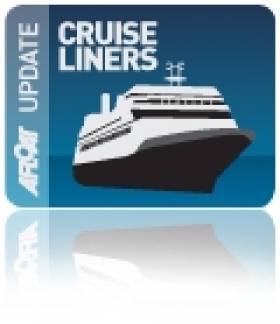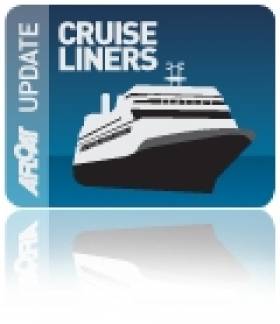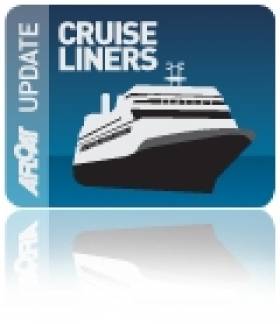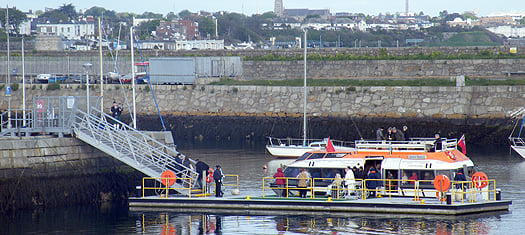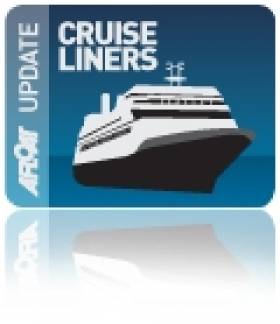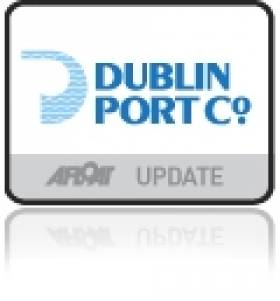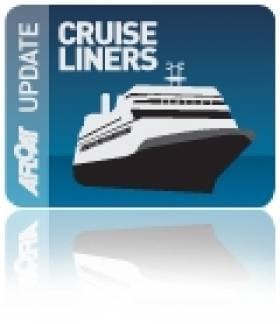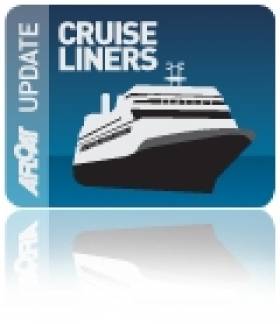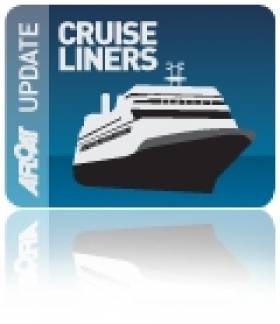Displaying items by tag: Cruise Liners
Morning Maiden Call of MSC Magnifica
#CruiseLiners – MSC Magnifica of 95,000 tonnes, made her maiden Irish call to Dublin Port this morning, she follows MSC Liricia, which last year visited the capital marking the first entry of MSC Cruises operations with calls to Ireland, writes Jehan Ashmore.
At nearly 300m long MSC Magnifica which cost $547million was completed in 2010 and she represents the latest of the 'Musica' class vessels. She has 16 decks in which 13 are exclusively for 2,500 passengers. Throughout these decks there are 17 bars, 5 restaurants, a theatre, library, card room, smoker's room and meeting room.
Among the other facilities, run by her 1,000 crew are the bowling alley, 3D cinema, a casino, internet point and three swimming pools, tennis court and for total relaxation the wellness and spa centre.
Shannon Cruiseship Season to Start with a Voyager
#CruiseLiners – The Shannon Estuary's main port of Foynes, the gateway to mid-western visitor attractions, is to welcome three cruise callers this season, starting next week with a call by Voyages of Discovery's 15,396 tonnes Voyager, writes Jehan Ashmore.
Holland America Line's 37,845 tonnes Prinsendam is due on 13 August and the final caller will be Pheonix Reisen's 28,856 tonnes Amadea which is scheduled to visit a month later on 13 September.
Last week SilverSeas six-star rated Silver Whisper which is today calling to Invergordon, Scotland, was to open the cruiseship season on the Shannon, however this was cancelled to weather related conditions.
She along with her expedition fleetmate Silver Explorer made a recent call together in Dublin Port. Silver Whisper moored alongside a berth close to the East-Link bridge.
This particular berth is currently re-occupied by the 19,000 tonnes Belize flagged bulk-carrier Clipper Faith which is advertised for public auction under the instructions of the Admiralty Marshall of the High Court.
#QM2Farewell– Queen Mary 2 under the command of master Kevin Oprey, weighed anchor in Dublin Bay yesterday evening after her historic maiden visit off Dun Laoghaire Harbour and from where a flotilla set out to take a final close-up view of the massive majestic liner, writes Jehan Ashmore.
She is certainly a vessel of superlatives, being the longest, tallest, widest and most expensive liner ever built, when launched in 2003. Among the facilities on the 14 deck liner are a 3D cinema and a planetarium.
Over 35 nationalities from every continent in the world including Ireland!... were represented among the passengers, with the majority coming from Germany (1,400) followed by the UK (760) and the US (200).
Today the liner is berthed at Liverpool Cruise Terminal. Her debut call to Dublin Bay is her third visit in Irish waters, following Cobh in 2011 and an anchorage call off Dunmore East, Waterford Estuary in 2005.
The QM2 had spent more than half a day in Dublin Bay while at anchorage with tenders kept busy plying to and fro to the passneger pontoon in the Coal Harbour while crowds of onlookers took to the seafront to view the impressive liner.
Her visit marked a significant milestone in the changing fortunes of Dun Laoghaire Harbour, as the Holyhead fast-ferry HSS Stena Explorer in recent years has reduced to a seasonal-only service. When introduced in 1996, the HSS fast-craft carried up to five round-trips daily.
To get a sense of the sheer size of the QM2 she is 72m high (keel to funnel) compared to the HSS fast-craft which is only 27.5m.

Anchor aweigh... starboard side of the liner. Photo Jehan Ashmore
The call by the famous Cunard Line 'flagship' is a major coup for Dun Laoghaire Harbour and the visit is estimated to generate a spend of €400,000 alone to the area.
Following the successful launch of the 2014 season by the QM2, the port also welcomed yesterday the small cruiseship Serenissima which docked within the harbour walls.
Over the next two months a further six cruise vessels are scheduled to visit, among them is P&O Cruises 710-passenger Adonia, which is due next week.
In total the port is to welcome be 14 callers bringing 30,000 passengers and generate an income of €3 million.
The cruising business is a growing market sector in the tourism industry and where Dun Laoghaire Harbour Company is to capitalise in this market with plans to develop a dedicated cruise terminal as part of the 'masterplan'.
The facility will be able to accommodate much larger cruiseships than present and with vessels up to 340m long.
#CruiseLiners – The dual serving liner and cruiseship Queen Mary 2 was not the only passenger vessel visiting Dublin Bay today, as the Serenissima docked within Dun Laoghaire Harbour and Artania called to Dublin Port, writes Jehan Ashmore.
The contrast could not be so diverse between the Dun Laoghaire cruise callers. The 2,620 passenger Cunard Line giant of 151,400 tonnes, making an impressive sight at anchorage (see web-cam) while Noble Caledonia's 2,500 tonnes Serenissima slipped into port berthing at Carlisle Pier. She had sailed overnight from Waterford and has accommodation for just over 100 passengers.
Serenissima is a former member of the Norwegian Hurtigruten Coastal Cruises fleet and her hull form and overall appearance certainly reflects her era. She was built in 1960 and launched as Harald Jarl serving a career along the many fjords of Norway.
As an exploration cruiseship she has also travelled to the other end of the world on cruises to the Antarctic under the name Andrea.
Also making a mid-May morning arrival albeit heading for Dublin Port was Phoenix Reisen Cruises Artania from Belfast.
The 44,500 tonnes Bermuda flagged vessel with a 1,200 passenger capacity was formerly launched for Princess Cruises as Royal Princess and christened by Diana, Princess of Wales.
#LinerQueenMary2 -RMS Queen Mary 2 the world's largest ocean liner made her maiden visit to Dublin Bay, anchoring offshore in calm sunny conditions off Dun Laoghaire Harbour early this morning.
A five star welcome saw 3,000 passengers greeted by a piper and Irish dancers, tour guides, free wireless and business offers after docking at the Old Coal Harbour.
The RMS Queen Mary II is the first of a flotilla of 14 floating visitors to dock in Dún Laoghaire this year, bringing over 30,000 cruise passengers, and generating an income of €3 million for the area. This compares with just 200 passengers arriving in the harbour in 2012.
The QM2 -the longest, tallest, widest and most expensive liner ever built - departed Greenock in Scotland yesterday for Dún Laoghaire and she will continue voyage this evening to Holyhead and Liverpool, followed by Invergordon, Stavanger in Norway and then Hamburg in Germany.
Over 35 nationalities from every continent in the world (including 6 from Ireland!) were represented among the passengers, with the majority coming from Germany (1,400) followed by the UK (760) and the US (200).
A 'mini cruise-festival' this afternoon, will celebrate the Queen Mary 2 arrival with family entertainment, boat trips circling the ship, face painting, a complimentary vintage bus, live music and dancing and special offers throughout the town.
Queen Mary 2 passengers disembark at the recently installed passenger pontoon in Dun Laoghaire's Coal harbour. Photo: Jehan Ashmore
Don McManus, Chairman of the Dún Laoghaire Business Association says excitement is rife among the Dún Laoghaire Business community: "The arrival of the Queen Mary 2 marks the beginning of a new era for Dún Laoghaire. The business community has been hugely supportive in funding the cruise welcome and associated publicity. The Queen Mary 2 alone will generate a spend in the region of €400,000 for the area. We have big plans to continue with the rapid development of the lucrative cruise market in the coming months and years."

The liner makes an impressive site from the Dun Laoghaire shoreline. Photo: Jehan Ashmore
"The cruise ship market is the fastest-growing sector in the travel and leisure industry. Globally, it is experiencing accelerated growth of 7.2 per cent per annum despite the tourism industry declining overall. It generates direct spend in Ireland in excess of €20 million per annum, however this is a tiny fraction of the €27 billion the market is worth globally.
"The continuous expansion of the market has increased demand for additional destinations for cruise line operators. By responding to the high standards set out by the cruise companies, Dún Laoghaire is capitalising on this opportunity and we anticipate rapid year on year growth for Dún Laoghaire in the industry."
"Research conducted by Fáilte Ireland in 2010 revealed that over 80% of passengers disembarking in Ireland considered Ireland an important destination in their itinerary. The opportunity is enormous. Dún Laoghaire is seizing this opportunity. By responding to what they want, we will attract the business."
The initiative is supported by Dún Laoghaire Harbour Company, Dún Laoghaire Rathdown Co. Council and the Dún Laoghaire Business Association.
PR from Dun Laoghaire Harbour Company Below:
Visit of Queen Mary 2 a Milestone in Development of Dún Laoghaire as Cruise Centre
Today (Thursday, May 16th) marks a significant milestone in the development of Dún Laoghaire Harbour as a location for visits by cruise ships, with the arrival this morning of the Queen Mary 2, flagship vessel of the famous Cunard line.
Around 4,000 passengers and 1,000 crew were on the vessel that arrived at 7.00am and will remain moored off the harbour until around 6.00pm this evening. Six further cruise vessels are expected to visit Dún Laoghaire Harbour over the next two months with a total of 14 expected over the full season.
Speaking after the arrival of the Queen Mary 2 this morning, the CEO of Dún Laoghaire Harbour Company, Gerry Dunne, said: "This is an historic day for Dún Laoghaire Harbour and augurs well for our plans to develop the harbour as the key port along the east coast for cruise visits."
"The cruise line business is a growing market sector in the tourism industry. Ireland has recently begun to capitalise on this market and over the last few years has succeeded in attracting a growing number of visits by cruise liners. However, the number of trips to Ireland represents a very small share of this potential market and the opportunity exists to grow this business to the Irish economy very significantly."
"Working with the Dún Laoghaire Cruise Stakeholder Group the Harbour Company has engaged in a vigorous marketing campaign, particularly in the United States, to enable Dún Laoghaire to tap into this lucrative market."
"To ensure that the harbour is also capable of catering for the 'new generation' of larger cruise vessels, the Stakeholder Group has initiated a Pre-Application Consultation with An Bord Pleanála under Section 37 of the Planning and Development Act, 2000 in regard to proposals for the construction of a new quay in Dún Laoghaire Harbour to cater for vessels of up to c.340m long. This is entirely consistent with the designation of Dún Laoghaire under the recently published National Ports Policy as a centre for marine related tourism and recreational activities."
"The visit of the Queen Mary 2 shows the potential of this sector of tourism to deliver significant economic benefit to Dún Laoghaire, the Greater Dublin area and the country in general".
#LinerQueenMary2- Queen Mary 2 is currently underway and bound for Dublin Bay, having departed Greenock Ocean Terminal, where she launched the cruise season at the Clyde port. Tomorrow morning the world's only 'liner' will make her historic maiden anchorage call off Dun Laoghaire Harbour, writes Jehan Ashmore.
The 345m Cunard Line 'flagship' was the first of five cruise call scheduled in just six days to visit Greenock from where the 2,600 passenger capacity liner mostly with passengers from Germany, had embarked on a cruise starting in Hamburg.
The call of Queen Mary 2 to the Scottish port is apt in that her predecessor Queen Elizabeth otherwise affectionately known as the 'QE2' was launched downriver on Clydebank at the John Brown shipyard and entered service in 1969.
The famous liner served on the trans-Atlantic 'liner' route until replaced by the considerably larger Queen Mary 2 or also referred as 'QM2' ' in 2004. Only twice has the Queen Elizabeth 2 visited Dublin Bay, on both occasions anchoring off Dun Laoghaire Harbour.
As the expectations rise of the arrival of Queen Mary 2 on the horizon of Dublin Bay so too will the looming giant all of 151,400 tonnes. The French built liner was launched in 2003 from the Chantiers de l'Atlantique shipyard in St. Nazaire near Nantes.
At around 06.00hrs tomorrow, a pilot cutter from Dublin Port will meet Queen Mary 2 on the fringes off the bay from where the 14 passenger deck ship will edge ever closer to anchor around an hour later some 1.2 nautical miles north-east of the East Pier lighthouse, which should give an excellent vantage point.
From around 07.30 tender craft from the liner are expected to shuttle to and fro to the cruise-dock tender pontoon in the Coal Harbour, where a 'five-star' welcome will see passengers greeted by a piper and Irish dancers as they embark.
A 'mini cruise-festival' for both cruise and domestic visitors will include family entertainment, face painting, a complimentary vintage bus and live music and dancing and special offers throughout the town.
In addition special QM2 themed boat excursions will be circling the liner during the afternoon before the liner is scheduled to depart around 17.30hrs.
It is estimated the visit to local economy will be boosted by €400,000 and places Dun Laoghaire Harbour on the map as a port of destination for larger international cruise operators.
Cruiseship Berths to be Much Closer up the Liffey
#DublinPort –Visiting cruise ships such as today's arrival of Le Boreal to Dublin Port are to be brought much further up the Liffey in a new plan to develop deep water berths.
Part of the river at Dublin Port is to be dredged to create a 12m deep channel for some of the world's biggest liners, up to 340m long, to dock beside the East Link toll bridge.
The development will be promoted with at least a quarter of the 100 cruise ships coming into Dublin this year using the berths. It will also ensure that tides will not stop the bigger ships getting closer to the city centre.
Dublin Port Company has begun a pre-planning consultation process and a planning application for the work to take place is expected to be submitted in September. The development intends to create room for two new cruise berths next to the toll bridge.
For more on this story, The Irish Times reports.
#CruiseLiners – Sea Explorer the small cruiseship which spent a brief 'lay-up' period in Dun Laoghaire Harbour during the Spring, as previously reported on Afloat.ie, returned to Dublin Bay today again 'without' passengers, with the ship docking instead in Dublin Port, writes Jehan Ashmore.
Since the departure of the 4,200 tonnes cruiseship from Dun Laoghaire Harbour, she has spent a further period of under lay-up in Barrow-in-Furness.
Sea Explorer berthed this morning at Ocean Pier, having sailed the Irish Sea from the Cumbrian port so to prepare the Italian built vessel for a new charter season for Copenhagen based Albratros Travel. The cruises will operate in Northern Europe and to Greenland.
Also in Dublin Port today is Le Boreal which berthed at North Wall Quay (close to the East-Link bridge), from where the detained cargoship Clipper Faith had to shift berths from this location and moor elsewhere in the port.
It will be a busy day for the port as third cruise caller is due this evening with Island Sky making a teatime arrival. She is one of eight sisters including Sea Explorer that were originally built for Renaissance Cruises.
#LinerQueenMary2 -Final preparations are underway as Dún Laoghaire gears up for the first ever visit of the world's only ocean liner – the giant RMS Queen Mary 2.
The impressive Cunard Line 'flagship' all of 151,400 tonnes, is due to anchor offshore of Dun Laoghaire Harbour on Thursday morning, at around 07.00hrs.She has a 2,600 passnenger capacity and a crew of 1,200.
Her inaugural call is to bring a €400,000 boost to the local economy during her one-day visit!
In total €3m is to be generated from the 2013 cruise season with 14 arrivals bringing 30,000 passengers to Dún Laoghaire Harbour. In stark contrast to last year when the port handled just 300 passengers.
A five star welcome will see the QM2 passengers greeted by a piper and Irish dancers as they embark at the old Coal Harbour, where the cruise-dock pontoon was installed last year for use by such large deep-drafted vessels and their tender craft.
To get around the town, a shuttle bus will bring passengers to receive a warm welcome in the grounds of the Royal Marine Hotel, where guests will be greeted with mini-samples of Guinness, character actors from local tourism sites.
A bespoke 'tourism office' with volunteers will provide tourism information and handing out booklets of vouchers and offers for shops, restaurants and tourism outlets in the area.
In addition a Dún Laoghaire phone app has been specially developed for cruise passengers to maximise enjoyment and avail of special discounts and offers while touring the town.
The Dún Laoghaire Cruise Stakeholders' Group has also installed an advanced wireless facility in Dún Laoghaire so passengers can enjoy extensive free internet access throughout the town itself and extending as far as the cruise liner during their stay.
A 'mini cruise-festival' for both cruise and domestic visitors will include food and craft markets, family entertainment, boat trips circling Queen Mary 2 and there is to be live music aired throughout the town.
Don McManus, chairman of the Dún Laoghaire Business Association says excitement is rife among the Dún Laoghaire Business community: "The arrival of the Queen Mary 2 on Thursday marks the beginning of a new era for Dún Laoghaire. The business community has been hugely supportive in funding the cruise welcome and associated publicity. We have big plans to continue with the rapid development of the lucrative cruise market in the coming years. Last year saw the arrival of just two cruise ships carrying 300 crew and passengers.
Following the establishment of a Dún Laoghaire Cruise Stakeholder Group and an aggressive international marketing strategy, this year we will welcome fourteen cruise ships with over 30,000 passengers and crew!"
The initiative is supported by Dún Laoghaire Harbour Company, Dún Laoghaire Rathdown Co. Council and the Dún Laoghaire Business Association
#MotorYacht - A striking looking Maltese flagged luxury charter motoryacht Lauren L, arrived this morning into Dublin Port to berth opposite the Poolbeg Yacht & Boat Club marina, writes Jehan Ashmore.
The 2,991 tonnes vessel built in Germany by the Cassens Werft shipyard, firstly began a career as a cruisehip. Under the name Sun Bay II, she made her debut season cruising in European waters and where she made a call to Dun Laoghaire Harbour, berthing alongside the ferry terminal at St. Michael's Wharf.
Under her current role, Lauren L as a charter yacht, she is able to host cocktail parties for up to 150 guests and overnight accommodation for 48 guests and all in the lap of luxury.
Features of the near 90m long vessel includes a conference room and centre, library, lido bar as well as a formal dining room plus a bow-mounted helicopter pad to shuttle guests to and fro.
Lauren L has a crew of 32 and she has worked in destinations such as the Cannes Film Festival. To charter the luxury motoryacht for a single week, this will set you back a mere €695,000, so get that lotto ticket!
She is approximately twice the size of the 52 passenger capacity cruisehip Quest, which called twice last year to Dun Laoghaire Harbour, where the port resumed in bringing this sector back after a break of more than a decade.
Next week, Dun Laoghaire Harbour looks forward in welcoming the giant 2,620 passenger liner Queen Mary 2. The Cunard Line 151,400 tonnes flagship will be making her maiden 'Dublin Bay' call with an anchorage call offshore of the harbour.






























